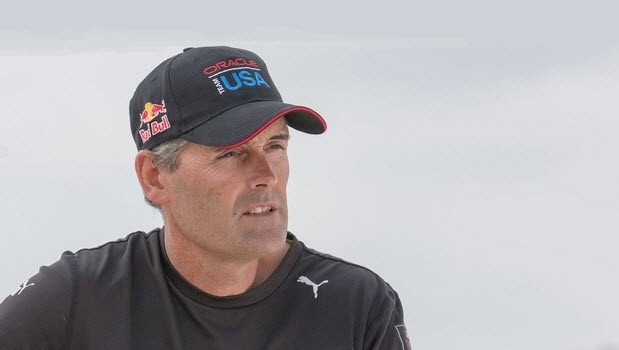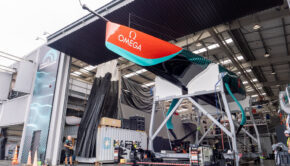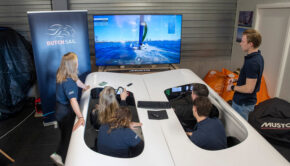America’s Cup: Dramatic changes anticipated for 35th edition
Published on January 5th, 2014
By Paul Lewis, NZ Herald
It’s all about the money. There are suggestions the 35th America’s Cup will now be fought out with team budgets of about US$80 million.
The last one required at least US$100m to be competitive and holders Oracle Team USA spent well over $200m and maybe much more.
But what’s not clear is how the budgets will be trimmed and how the suggested format of the next America’s Cup will lend itself to such a financial “haircut”.
Everyone is waiting for OTUSA to release their protocol, the guiding rules covering the timing, location, format, type of boat and other elements. Without that, potential challengers cannot assess their ability to compete and the cost of doing so.
However, OTUSA are now working with the challenger of record – Australia’s Hamilton Island Yacht Club – to nut out the basis for the next protocol and, inevitably, some current thinking has dribbled out.
Here’s what we suspect so far:
• 60 to 65-foot foiling catamarans: These would be smaller than the AC72s which so captured the imagination in San Francisco last year but still lightning fast foilers which can produce the thrills seen in last year’s regatta. They can be sailed by 7-9 crew members, thus reducing crew costs. The AC72s had 11 crew.
• More common design elements: This would reduce the scope for design. The giant wingsails and even the hulls could be of identical design, thus reducing the need to have huge teams of designers. The foils and their controls would be one of the few areas left open to design interpretation. That would reduce designer and boatbuilding costs; people are by far the biggest financial drain on competing syndicates.
• More challengers: Already there are signs that Emirates Team New Zealand, Artemis and Luna Rossa will be involved along with the Australian syndicate. A British team (headed by former OTUSA team member Sir Ben Ainslie) is reported to be close to attracting enough funding to launch a challenge this year. There’s also a powerful French syndicate forming under Yacht Club de France colours, though no signs yet that they have the money to float their boat. So, a possibility of six challengers, maybe more.
• Global regattas: It has been suggested OTUSA are insisting that each entrant for the 35th America’s Cup would host an event in their own back yard – so in 2015 and 2016, there could be America’s Cup regattas in Australia, New Zealand, Sweden (Artemis), Italy (Luna Rossa), Britain and France. Each syndicate would own the financial structure of the event, thus lessening the burden on OTUSA and billionaire backer Larry Ellison.
• New boats: These global regattas would be in the 45-foot AC45 catamarans used in the build-up to the last Cup or something similar. This time, the AC45s will likely have foiling capability (they didn’t in the last America’s Cup World Series, as the AC45 series was known) to take advantage of the excitement of foiling and to link the series more firmly to the main event – the America’s Cup match between defender and challenger.
• Elimination series: That match will be held in San Francisco (everyone’s preferred venue if it works out) in 2017. The proposal is that the top four challengers from the 2015 and 2016 America’s Cup World Series (ACWS) qualify for the Louis Vuitton regatta, where the challengers race off to find the one boat to face Oracle in the Cup match. Once those four challengers are found, they would have approximately a year to build their 65-foot America’s Cup boat.
• Departure from tradition: That means the build-up events will have a serious say in who gets to go to San Francisco, a real change from the previous system where all challengers converge on the venue for the Louis Vuitton Cup and then the Cup match. This could reduce venue costs by staging the “finals” over a tighter time frame than the months such events normally take. Coutts has also said in the recent past that many challengers in bigger Louis Vuitton fields were not competitive and were merely making up the numbers. This approach would cull out such challenges.
But here’s where it gets a bit murky. The US$80 million budget is, according to some sources, what Ellison has instructed OTUSA chief executive Sir Russell Coutts that he has to work with. That’s likely because, over the years and various tilts at the Cup, Ellison must have spent somewhere close to the vicinity of US$1 billion.
If the US$80m restriction is correct, it suggests some kind of budget cap might be on the horizon – as the defender is never deliberately going to allow a challenger to outspend them to win the Cup.
In addition, it is not yet clear just how building a new AC45 (which then has to be transported around the world) and then a new AC65 will help teams come in under the previous US$100m budget standard.
Coutts has already made suggestions that large savings can be made in transportation and combined use of bases and facilities – but how is not yet clear.
Worse, challengers are faced with a scenario where they need sponsorship now – but sponsors will not know until the ACWS is run whether they will be going to San Francisco or not. It seems unlikely that corporate sponsors would risk many millions of dollars on such a punt. This may be the big sticking point in current negotiations between defender and challengers.
Some traditionalists are taking the view that Ellison and Coutts are paying lip service to cost reductions while reducing their own financial burden and not worrying too much about challenger numbers.
One America’s Cup source, who asked not to be named, said plans to change the Cup format was steeped in self-interest: “In my view, this approach is all about watering down the America’s Cup and building up the ACWS; building up the commercial aspects as opposed to the traditions of the regatta. The Cup is the Cup. It shouldn’t be manipulated and upset for ulterior motives. If you want a yearly regatta, go buy your own piece of silverware and call it something else.
“Everyone fears Larry Ellison and his financial power. No one wants to end up in a legal argument with him and his resources. But we now have a situation where the team that was found to include cheats in the ACWS last time is changing the America’s Cup.”
However, it seems likely that OTUSA will want to boost the credibility of the regatta after last time. Amid all the excitement of Oracle’s compelling comeback win last year, it has been largely forgotten that only Team NZ and Oracle were competitive in the build-up. Artemis were ineffectual and Luna Rossa – even though they shared design knowledge with Team NZ – were also off the pace.
Attracting only three challengers (only two of whom played a real role in proceedings) threatened to make a mockery of an America’s Cup regatta which has had many more challengers in the past. It also dented the credibility of the Louis Vuitton Cup, awarded to the winner of the challenger series.
If OTUSA is sincere about keeping sport’s oldest (and one of the most significant) sponsorships, it will need to produce more than the lame duck regatta of last time; Louis Vuitton are not known for backing lame ducks.
That suggests cost reduction efforts will be genuinely pursued. Cost and Oracle’s considerable technological lead and experience in giant multi-hulls were all factors in potential challengers dropping out last time – and Ellison will not want his credibility swamped again under a wave of no-shows.
While the current interest and Australian challenger of record looks good, it should not be forgotten that the challenger of record last time, Mascalzone Latino, held that position right up until the time that they realised they could not afford to compete – and pulled out.
There are other questions that will not be answered until OTUSA’s protocol is released – and the devil may be in the details.
There were signs that OTUSA, angry at the jury finding against them over the cheating allegations, were moving towards the idea of an independent commissioner to rule on technical and legal protests – rather than the independent jury of last time.
That jury lived up to its name – it was clearly independent and was not ruled by political pressure from the holder; many decisions went in Team NZ’s favour although the final one (the suggestion that Oracle’s system powering the foils was illegal) didn’t and was a big reason why Team NZ did not win the Cup.
Some critics fear that an independent commissioner appointed by OTUSA will not be independent at all. If they do decide on a commissioner, that could bring OTUSA into conflict with ISAF, the international sailing federation under whose banner the Cup is run.
ISAF also oversee sailing’s participation in the Olympics and conflict could mean that anyone in a Cup team could be barred from competing in the Olympics. Ainslie and OTUSA’s Tom Slingsby have already cast their lot with the Cup and have said they will not be competing in the Olympics but many Cup sailors build their careers on Olympic participation and success.
However, this is far into the realms of speculation. The questions will be answered when OTUSA releases the protocol, probably in March, and we will be able to assess exactly where OTUSA are taking the America’s Cup.
Source: http://www.nzherald.co.nz/sport/news/article.cfm?c_id=4&objectid=11181428









 We’ll keep your information safe.
We’ll keep your information safe.